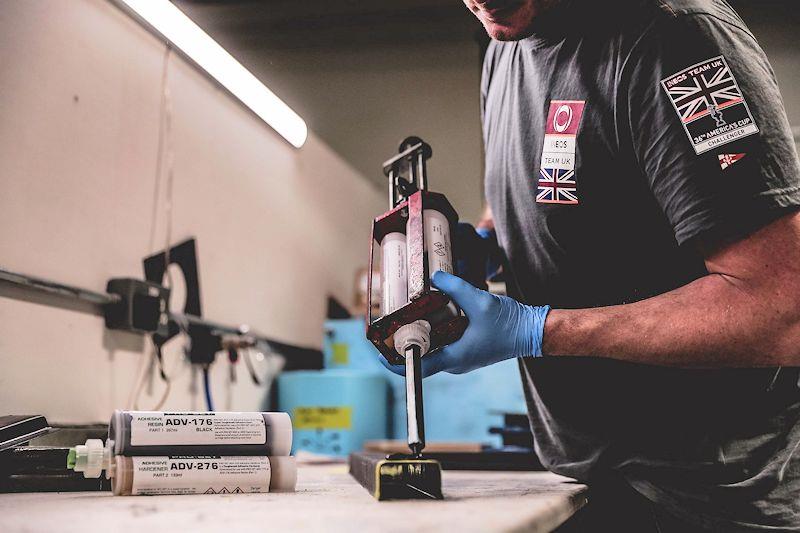
The stuff AC75s are made of
by Epoxycraft 9 Mar 2020 05:00 PDT

INEOS TEAM UK using PRO-SET Super Toughened Epoxy Adhesive © Harry KH / INEOS TEAM UK
In the high speed, high stress world of the America's Cup, keeping the beast in one piece is clearly a big challenge, reports Matt Sheahan in Seahorse Magazine. Structural attachments that require an adhesive bond need a strong yet toughened epoxy adhesive to transmit loads between components.
Achieving both strength and toughness can be tricky. PRO-SET® ADV-176/276 Super Toughened Epoxy Adhesive delivers just this.
"It might be good to have a very strong bond but you don't want one which just lets go without any warning," says INEOS TEAM UK's manufacturing manager Michel Marie.
"Over the years, as resins epoxies have been developed to be tougher, they have also needed to be more flexible so they can withstand a certain amount of displacement without breaking the bond."
So how are these key properties achieved?
"We refer to it as a super toughened adhesive," explains David Johnson of Wessex Resins. "The formulation includes nitrile rubber toughening additives that limit crack propagation through a joint when it's highly loaded so you don't get catastrophic failure.
"Without these toughening additives, crack propagation occurs a lot more readily and can lead to bond failures. The rubber particles in the bond create cavitation sites within the adhesive interface and, if a crack does develop, shear-band yielding occurs around the particles rather than shearing straight through the material. As a result a crack is contained within the bond line."
But minimising and containing fractures is only part of the technical benefits. Temperature is another important factor.
"The epoxy systems we use for assembling various prepreg components cure at room temperatures," continues Marie. 'They are used to attach the structure inside the hull shell for example, or to bond the deck to the hull so they are very important high stress connections between the primary element of the structures.
"PRO-SET Super Toughened Adhesive epoxy system is a very good product that we really like because it prevents the formation of voids in the bond line. This epoxy allows good control of the viscosity, which in turn allows us to make blind bonds without accidental voids which is always the tricky part of the process. In order to achieve a good consistent bond you need a product that flows well and gets into all the areas. But a product with a low viscosity that might achieve this could run away from the key area. Striking the right balance between a product that will flow and one that isn't so viscous that air bubbles get trapped in the bond line, is a tricky one to achieve but the PRO-SET ADV-176/ADV-276 Super Toughened Epoxy Adhesive system delivers just this."
The ability to achieve high strength bonds at room temperatures is also key.
"As with any modern composite structure there will be a post cure process at some stage to achieve the final high structural properties of the entire structure but what we're after with those resin epoxy systems is versatility throughout a full range of temperatures," continues Marie. "For example, in the middle of winter when you glue things together you might not necessarily be in a warm environment. Those resin epoxy systems need to be to be hard at the end of the day or the next morning. So we require a lot from those materials."
Shipping can also be a consideration when it comes to temperatures at which materials are cured. This is yet another of the many details that need to be considered during the development of a bonding system.
"Shipping carbon structures around the world in containers can produce a challenging set of conditions for modern composites," says Wessex Resins' David Johnson. "During a trip, containers can act as humid ovens at times that could reach 100 degreesC inside. Then when the structure is on location, surface temperatures can easily reach up to about 80 degreesC plus, so the material needs to have good thermal properties wherever it's being assembled."
With the new America's Cup cycle taking the technical challenge onto another level, those close to the design and construction of the new breed are in no doubt as to how the structural demands will increase once again this time around.
"This is my ninth America's Cup and the nature of the game is always to push a bit further with every cycle," says Marie. "The AC75 Class rule is very exciting because the design space is really open and there's a lot of time spent at the engineering stage to cater for loads that are much higher than they were for the AC50."
Having faith in materials is key and when it comes to PRO-SET adhesive products, Marie is clear. "The boat builders like it which is always important."
Look into PRO-SET® or, to read about other interesting stories from Wessex Resins & Adhesives please visit epoxycraft.com